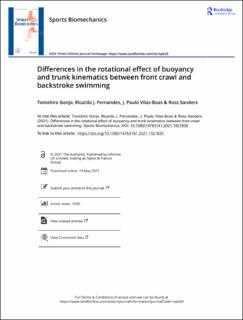| dc.contributor.author | Gonjo, Tomohiro | |
| dc.contributor.author | Fernandes, Ricardo J. | |
| dc.contributor.author | Vilas-Boas, J. Paulo | |
| dc.contributor.author | Sanders, Ross | |
| dc.date.accessioned | 2022-03-21T16:11:44Z | |
| dc.date.available | 2022-03-21T16:11:44Z | |
| dc.date.created | 2021-06-09T17:11:41Z | |
| dc.date.issued | 2021 | |
| dc.identifier.citation | Sports Biomechanics. 2021, Artikkel 1921835. | en_US |
| dc.identifier.issn | 1476-3141 | |
| dc.identifier.uri | https://hdl.handle.net/11250/2986628 | |
| dc.description | This is an Open Access article distributed under the terms of the Creative Commons Attribution-NonCommercial-NoDerivatives License (http://creativecommons.org/licenses/by-nc-nd/4.0/), which permits non-commercial re-use, distribution, and reproduction in any medium, provided the original work is properly cited, and is not altered, transformed, or built upon in any way. | en_US |
| dc.description.abstract | The purpose of the present study is to investigate differences between front crawl and backstroke swimming in hydrodynamic (produced by swimmers) and buoyant torque around the transverse axis. Ten swimmers performed 50 m front crawl and backstroke at four selected velocities (same velocities for both techniques). All trials were recorded by four underwater and two above-water cameras to collect data for three-dimensional whole-body motion during one stroke cycle (defined as a period between two consecutive wrist entries to the water). The inverse dynamics approach was applied to obtain buoyant and hydrodynamic torque around the transverse axis. The differences between front crawl and backstroke techniques across four levels of velocity were assessed with a two-way repeated-measures ANOVA. There was a main effect of technique on the mean buoyant and hydrodynamic torque, with 30–40 % larger leg-raising buoyant torque and leg sinking hydrodynamic torque in front crawl than in backstroke (p ≤ 0.001). The time-series data revealed that the hydrodynamic leg-sinking torque had its peaks during the first half of the underwater upper-limb motion in front crawl, but that was not observed in backstroke, implying that the strategy of counterbalancing the buoyant torque is different between the techniques. | en_US |
| dc.language.iso | eng | en_US |
| dc.subject | alternating techniques | en_US |
| dc.subject | aquatic locomotion | en_US |
| dc.subject | buoyant torque | en_US |
| dc.subject | inverse dynamics | en_US |
| dc.title | Differences in the rotational effect of buoyancy and trunk kinematics between front crawl and backstroke swimming | en_US |
| dc.type | Peer reviewed | en_US |
| dc.type | Journal article | en_US |
| dc.description.version | publishedVersion | en_US |
| dc.rights.holder | © 2021 The Author(s) | en_US |
| dc.source.pagenumber | 12 | en_US |
| dc.source.journal | Sports Biomechanics | en_US |
| dc.identifier.doi | 10.1080/14763141.2021.1921835 | |
| dc.identifier.cristin | 1914903 | |
| dc.description.localcode | Institutt for fysisk prestasjonsevne / Department of Physical Performance | en_US |
| dc.source.articlenumber | 1921835 | en_US |
| cristin.ispublished | true | |
| cristin.fulltext | original | |
| cristin.qualitycode | 1 | |
